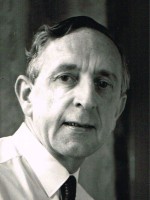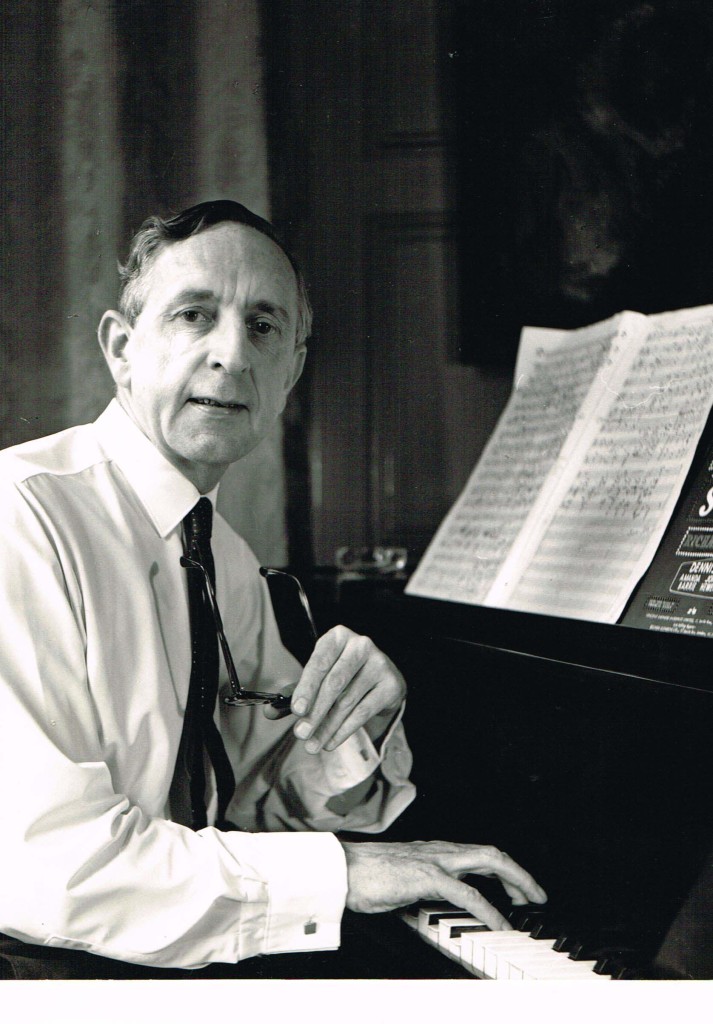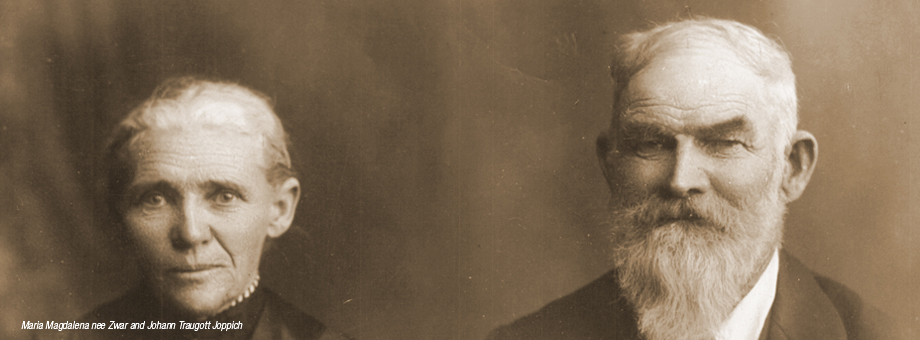
Charles Joseph Zwar (E8.3)
- Born: 10th April 1911
- Parents:
Charles Henry and Eliza Mary Zwar nee Richards - Isobel Ann Shead 28.4.1938
- Diana Plunkett 1955
- Lived:
Broadford, Australia. England - Died: 2nd December 1989 Oxford, England
- Buried:
- Married:
Detailed biography by his daughter Mary-Jane
Charles Joseph Zwar
Songwriter, Composer, Lyricist, Pianist and Music Director
Father and Mother
Charles talked a lot about his mother ( Eliza Mary nee Richards ) but very little about his father ( Charles Henry Zwar ). His father died in 1921, when C J was ten. He said that his father was in the Australian Army and was “shot up at Gallipoli”. He remembers his mother being the driving force behind the running of the farm, “The Ranch” at Broadford.
His mother Eliza Mary was born in Cornwall, England. She was very musical and led other members of the family in a small band, providing music for local weddings and parties. This continued throughout her life as his brothers Dick and Dolph were both musical.
Although basically Church of England, she happily donated organs and other musical instruments to many local churches of many denominations.
She was a great collector of gadgets and The Ranch used to have a great collection of early washing machines, radios, refrigerators, gramophones etc. . .
The Youngest
Charles was born on 10th April 1911, the youngest of three brothers. Their mother had very much hoped to have a daughter and early photos show CJ in very frilly clothes, with long locks. which he says he hated. He seems to have been her favourite, perhaps influenced by a near fatal attack of typhoid fever which he had when aged about three or four. It left him deaf in one ear. He remembers that his mother got a Broadford brass band to play outside “The Ranch” as a treat for him and to celebrate his convalescence.
Eliza Mary always had time for the weak, including an almost constant succession of injured or orphaned young animals – wild and farm – which were nursed in a basket beside the kitchen range. A cockatoo became a family pet for many years. CJ remembers that it used to imitate his eldest brother and call the dog to fetch the cows in for milking at the correct time.
Music
Eliza Mary encouraged CJ’s musical ability. He was taught the violin from an early age and she hoped he would become a virtuoso player. He was taught by G Walther, a leading teacher of the day in Melbourne and, indeed, performed with Kreisler when he toured Australia. A fall from a horse that broke his arm in his early teens put an end to these hopes. I think he was about ten or twelve at the time.
School and Law
He first attended a local government school in Broadford, but later went to Williamstown School. He followed his elder brother Dolph (Adolphus Gordon, known as AG) to Trinity College, Melbourne University at the age of 15, in 1926, to read Law. He wished to study music and composition but his mother pushed him into Law. After completing his Law degree he then studied music.
Student Reviews
During his time at Trinity he contributed to several student revues and some of these songs are mentioned in Graham Mclnnes’ book “Humping my Bluey”. Some people have attributed his nickname AG to his AGonised expressions while playing the
piano, but it was simply an inheritance from Dolph’s name. Several scores from these revues are in my possession.
He was a regular performer and composer for Australian radio.
Blue Mountain Melody
His success in these revues (Hot Swots; Swot Next: Stude Prunes….) led to him being asked to write the musical comedy Blue Mountain Melody. The book for the musical was written by Jimmy Bancks, of Ginger Megs fame, and Charles wrote both the lyrics and the entire score (including, I think, most of the orchestration). Blue Mountain Melody was one of the most ambitious productions of its day. It was performed at the Theatre Royal, Sydney by J C Williamson Ltd and its producer was Frederick Blackman. Unlike most musicals which were imported from Britain or the States, Blue Mountain Melody was “an all Australian musical” with an extremely talented Australian cast led by Cyril Ritchard and his wife Madge Elliott. Its premiere was on the 15th September 1934. After a successful run in Sydney, the show was transferred to Melbourne. The title song and another song called I can see a Picture were recorded by Jim Davidson and his Orchestra and parts of the score were published by Aliens.
Great Britain and Marriage
Charles was encouraged by this success and by Cyril Ritchards and Madge Elliott to leave Australia for Great Britain. He was accompanied by Isobel Ann Shead and the two were later married at Shere in Surrey on 28/04/1938. Professor Bernard Heinze was best man at their wedding. Coincidentally Professor Heinze’s grandson is a good friend of Charles nephew Richard.
Isobel Ann, usually known as Ann, was a writer and broadcaster. She worked for Australian radio and subsequently for the B.B.C. She was the author of many books for children including Sandy (1935), Mike. Off the chain. Clancy. To see the Queen and several others. In Australia her books were published by Hutchinson and in England by Faber and Faber.
On the ship to England, he listened to the abdication speech.
The Gate Theatre
Charles began work in London at The Gate Theatre, a small theatre club owned and managed by Norman Marshall in Villiers Street. Because of its status as a club, Norman Marshall was able to put on many avant-garde productions which would not have been permitted by the Lord Chamberlain in ordinary theatres. Norman Marshall’s cast also put on several intimate revues, some (such as The Gate Revue and Swinging the Gate) transferred to other West End theatres. Charles was pianist at the Gate and composed many scores for these revues. The cast for these revues included many young actors such as Peter Ustinov and Hermione Gingold.
War Service
At the outbreak of war Charles enrolled in the army (Royal Engineers) and was sent to train at Bulford on the Salisbury Plain. His poor chest precluded active service so he was used administratively. He was transferred to the Australian Army fairly early on. He was soon back in London with Ann and was thus able to combine war service with theatrical work. He tells of fire-watching on the dome of St Paul’s Cathedral.
 Charles Joseph Zwar
Charles Joseph Zwar
“Which witch?”
In 1942 he collaborated with Alan Melville to write a song for Hermione Gingold for the revue Sky High: “Which witch?” has been recorded several times and has most recently been performed in a revue by the Royal Shakespeare Company in 1994.
He also contributed numbers to the revues:
Sweet & Low and Sweeter & Lower. He and Alan Melville wrote the entire revue Sweetest & Lowest, which was at the Ambassadors Theatre. The Sweet & Low etc series ran for over 7 years.
Music for Films
During this time he also composed the music for two films: The Australian Army at War and Hello Fame (a film revue starring many of the actors from the Gate Theatre, which was sadly bombed).
Duchess Mews
Charles and Ann were living in a small flat in Duchess Mews near the BBC at this time, but they also rented a small cottage called Hoghurst, near Fittleworth in West Sussex to relax in. Ann, as always, had at least one spaniel.
A la Carte
After the war, Charles continued to collaborate with Alan Melville and together they wrote the whole of the revue A la Carte in 1948 which ran at the Savoy Theatre.
Charles also contributed to many other revues in the late ’40s and ’50s; mostly collaborating with Alan Melville, but also composing for others such as Gerard Bryant, Paul Dehn and Michael Flanders.
Separation
Charles and Ann separated and were subsequently divorced in about 1951/52. They had no children. Ann died in England – in 1985, I think.
Lyric Review
In 1951/52 he contributed numbers to the Lyric Revue, staged at the Lyric Theatre, Hannersmith under the management of “Binkie” Beaumont. Working as Tennants’ agent at the theatre was Diana Plunkett who would become Charles’ second wife in 1955. These sketches include some of his favourites: Bar at the Folies Bergeres and Home Again. At the same time he contributed twelve numbers to the musical Bet Your Life which starred Arthur Askey.
Marigold
Charles wrote the music for a second musical in 1958. Alan Melville adapted the play Marigold by Allen Harker and FR Pryor which had had great success before the war. With its Scottish setting, it had a popular run in Edinburgh but was less successful in London. At this time the nature of revue and stage comedy was changing greatly because of an influx of brilliant young talent from Oxford and the Cambridge Footlights: Peter Cook, Dudley Moore, Alan Bennett and Jonathan Miller whose first hit was Beyond the Fringe.
Marriage
In 1955, Charles married Diana Plunkett. He was then living in a flat in Lansdowne Terrace in Bloomsbury near the British Museum.
Daughter
After the birth of their only daughter, Mary-Jane, in 1957 they moved to a flat in Chelsea.
By this time, Diana had left the Lyric Hammersmith but she continued to work as director of the company Stagesound Ltd which she had co-founded in 1948 with William Walton, theatre electrician at the Lyric Hammersmith. Stagesound had a recording studio in Covent Garden and provided sound systems for many of the London theatres. She remained with Stagesound until after its take-over by Theatre Projects Ltd in the mid ’70s.
Television
During the ’50s, television was becoming more important as a vehicle for comedy and revue. Charles and Alan Melville had several radio and TV series (Melvillainy and A to Z).
In the early ’60s two further revues were written: All Square and Six of One which starred Beryl Reid, Naunton Wayne, Dora Bryan and many others.
House bound
Charles’ health had never been very good: he suffered from asthma and frequent severe migraines. He worked less frequently as the ’60s progressed and was effectively housebound for the last fifteen years of his life. In 1985, he and Diana moved to Headington in Oxford when Diana retired. He was frequently hospitalized and died of leukemia on the 2nd December 1989.
Diana died on the 2nd September 1992.
Mary-Jane had married Gordon Jeanes in 1980. They have three children: Emily, Catherine and Christopher .
Mary-Jane has much of Charles’ music and his piano which the children are learning to play.
Revivals
There have been several revivals of Charles’s music: Meet me at the Gate in 1985 and Now and Then in 1994 at the King’s Head Theatre in Islington, London; Which witch? from the 1942 revue Sky High was performed by Abigail McKern in the Royal Shakespeare Company’s The Shakespeare Revue in 1994/95.
________________________________________________________
© Mary-Jane

